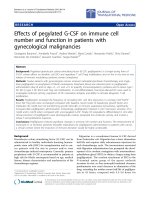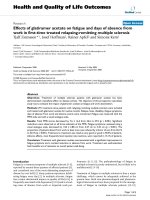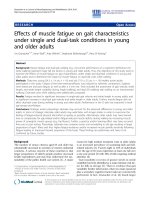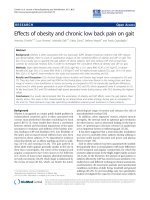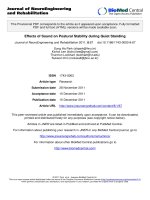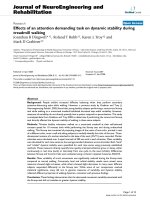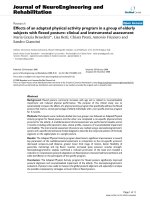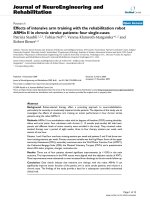Báo cáo hóa học: " Effects of an adapted physical activity program in a group of elderly subjects with flexed posture: clinical and instrumental assessment" pot
Bạn đang xem bản rút gọn của tài liệu. Xem và tải ngay bản đầy đủ của tài liệu tại đây (470.84 KB, 11 trang )
BioMed Central
Page 1 of 11
(page number not for citation purposes)
Journal of NeuroEngineering and
Rehabilitation
Open Access
Research
Effects of an adapted physical activity program in a group of elderly
subjects with flexed posture: clinical and instrumental assessment
Maria Grazia Benedetti*, Lisa Berti, Chiara Presti, Antonio Frizziero and
Sandro Giannini
Address: Movement Analysis Laboratory, Rizzoli Orthopaedic Institute, via di Barbiano 1/10, 40136 Bologna, Italy
Email: Maria Grazia Benedetti* - ; Lisa Berti - ; Chiara Presti - ;
Antonio Frizziero - ; Sandro Giannini -
* Corresponding author
Abstract
Background: Flexed posture commonly increases with age and is related to musculoskeletal
impairment and reduced physical performance. The purpose of this clinical study was to
systematically compare the effects of a physical activity program that specifically address the flexed
posture that marks a certain percentage of elderly individuals with a non specific exercise program
for 3 months.
Methods: Participants were randomly divided into two groups: one followed an Adapted Physical
Activity program for flexed posture and the other one completed a non-specific physical activity
protocol for the elderly. A multidimensional clinical assessment was performed at baseline and at
3 months including anthropometric data, clinical profile, measures of musculoskeletal impairment
and disability. The instrumental assessment of posture was realized using a stereophotogrammetric
system and a specific biomechanical model designed to describe the reciprocal position of the body
segments on the sagittal plane in a upright posture.
Results: The Adapted Physical Activity program determined a significant improvement in several
key parameters of the multidimensional assessment in comparison to the non-specific protocol:
decreased occiput-to-wall distance, greater lower limb range of motion, better flexibility of
pectoralis, hamstrings and hip flexor muscles, increased spine extensor muscles strength.
Stereophotogrammetric analysis confirmed a reduced protrusion of the head and revealed a
reduction in compensative postural adaptations to flexed posture characterized by knee flexion and
ankle dorsiflexion in the participants of the specific program.
Conclusion: The Adapted Physical Activity program for flexed posture significantly improved
postural alignment and musculoskeletal impairment of the elderly. The stereophotogrammetric
evaluation of posture was useful to measure the global postural alignment and especially to analyse
the possible compensatory strategies at lower limbs in flexed posture.
Published: 25 November 2008
Journal of NeuroEngineering and Rehabilitation 2008, 5:32 doi:10.1186/1743-0003-5-32
Received: 20 February 2008
Accepted: 25 November 2008
This article is available from: />© 2008 Benedetti et al; licensee BioMed Central Ltd.
This is an Open Access article distributed under the terms of the Creative Commons Attribution License ( />),
which permits unrestricted use, distribution, and reproduction in any medium, provided the original work is properly cited.
Journal of NeuroEngineering and Rehabilitation 2008, 5:32 />Page 2 of 11
(page number not for citation purposes)
Background
The aging process modifies normal postural alignment,
and flexed posture commonly increases with age. Thoracic
kyphosis and protrusion of the head, and in more severe
cases, knee flexion, characterize flexed posture [1-5].
Although the precise etiology of flexed posture (FP) is
unknown, its pathophysiology in the elderly is most likely
multifactorial and can be associated with low bone min-
eral density and consequently vertebral fractures, and also
degenerative alterations of intervertebral disks [2,6-12]. It
is also related to musculoskeletal and neuromuscular
impairments [13-15]: deficit in spinal extensor muscle
strength and shoulder and hip range of motion decreasing
have been correlated with flexed posture [1,14-18].
Increased flexed posture has been associated with less
independence when performing activities of daily living
and reduced physical performance, such as impaired bal-
ance, reduced postural control and slower walking, as well
as risk of falling [1,13,14,19-26]. Moreover kyphosis and
compensative cervical and lumbar spine hyperlordosis
can cause pain due to ligaments and muscles impairment
[11,22].
There is no standard approach to measure flexed posture
and classification methods are very complex [27]. Clinical
assessments present the advantages of simplicity, low-cost
and wide application, such as the occiput-to-wall distance
[1] that classifies the severity of flexed posture. On the
other hand, instrumental evaluation enables quantitative
analysis of the global body alignment in flexed posture
patients and especially the compensatory axial alterations
at the head and lower limbs. In the literature, several stud-
ies have reported the use of goniometers, inclinometers
[28,29], electrogoniometers [30], stadiometers [31-33]
and photometric techniques [29,34-36]. The more recent
stereophotogrammetric systems [37-39] seem to realize
more reliable and valid evaluations of postural alignment
analysis.
A sedentary life style is supposed to play a fundamental
role in developing a flexed posture and there is evidence
in literature that appropriate physical activity programs
can correct this attitude [1].
There are few studies that investigate methods to improve
flexed posture, and especially the relationship with the
multiple impairments associated to flexed posture
[17,40,41]. Sinaki [14,16,42-47] focused most research
on the correlation among osteoporosis, kyphosis and
back extensors strength and defined an exercise program
based on isometric back-extensor strengthening and pro-
prioceptive postural retraining to contain flexed posture
[17,48-50]. In different studies, the same author analyzed
the role of the physical activity program in improving bal-
ance, gait and quality of life and the consequences in
reducing back pain, risk of falls and vertebral fractures
[17,46,49-51]. The efficacy of these protocols seems to
correlate to exercise specificity, but we failed to find suffi-
cient randomized controlled trials in the literature that
compare different programs.
Based on Sinaki's experience, we hypothesized that an
Adapted Physical Activity (APA) program with specific
exercises for flexed posture would improve postural align-
ment and physical performance in a more effective way
than a non-specific physical activity protocol for the eld-
erly. The purpose of this clinical study was to systemati-
cally compare the effects of a physical activity program
that specifically address the flexed posture that marks a
certain percentage of elderly individuals with a non spe-
cific exercise program for 3 months. A clinical multidi-
mensional assessment [1], including evaluation of
musculoskeletal impairment, motor function, and disa-
bility, and an instrumental assessment of global postural
alignment were used as measures of outcome.
Methods
Subjects
The study included elderly subjects aged over 65 years
with flexed posture. Fifty-one participants were recruited
from a Senior Club and provided written informed con-
sent to take part in the study. After multidimensional clin-
ical assessment seventeen subjects were not enrolled
because they had one of the following exclusion criteria:
central nervous system disorders, secondary osteoporosis,
postural hypotension, disabling blindness or deafness,
known malignant neoplasia, history of known vertebral
fractures, obesity with Body Mass Index (BMI) >30, Mini-
Mental State Examination (MMS) [52] >23, New York
Heart Association (NYHA) classification >1, Short Physi-
cal Performance Battery (SPPB) [53,54] with 1 item = 1.
The 34 subjects included in the study, (28 women and 6
men) with a mean age of 70.9 years (S.D. 5.1), were ran-
domly divided into two therapeutic groups: Group APA
followed an Adapted Physical Activity (APA) program
with specific exercises for flexed posture and Group NSPA
followed a non-specific physical activity (NSPA) protocol
for the elderly. In both groups exercises were performed 2
days a week for 1 hour and the program lasted for 3
months.
The participants that completed the two programs (at
least 80% of sessions) were: 15 subjects in Group APA (12
females and 3 males) with a mean age of 71.5 (S.D. 4.3),
weight 66.5 kg (S.D. 9.8), height 156.9 cm (S.D. 10.5) and
BMI 27.22 (S.D. 4.5); and 13 subjects in Group NSPA (10
females and 3 males) with a mean age of 71.5 (S.D. 4.9),
Journal of NeuroEngineering and Rehabilitation 2008, 5:32 />Page 3 of 11
(page number not for citation purposes)
weight 72.7 kg (S.D. 11.1), height 159.5 (S.D. 8.7) and
BMI 28.79 (S.D. 5.2).
The research protocol was approved by the Rizzoli Ortho-
pedic Institute Ethics Committee.
Intervention
The exercises proposed for the APA group were aimed at
improving flexibility at pelvic and shoulder girdle, and at
strengthening back extensor muscles fighting the attitude
to flexed posture. Most of exercises for back strengthening
were selected among those proposed by Sinaki [49,51,55-
57]. The set of exercises was discussed with the two phys-
ical trainers in charge for the groups management, in
order to select exercises focused on specific impairment.
We know in fact that both a deficit in spinal extensor mus-
cle strength and reduction of flexibility at shoulders and
hips have been correlated with flexed posture.
In both groups exercise sessions began with 10 minutes'
warm-up and ended with 10 minutes' cool-down.
1. In a sitting position with hands behind the head, deep-
breathing-in exercise combined with pushing elbows
backwards. Then back to the initial position (10 repeti-
tions).
2. In a sitting position with slightly flexed elbows, deep-
breathing-in exercise combined with shoulder extension
and adduction, and neck extension. Then back to the ini-
tial position (10 repetitions).
3. In a sitting position with arms along the sides, deep-
breathing-in exercise combined with shoulder elevation.
Then back to the initial position (10 repetitions).
4. In a sitting position with hands on thighs, deep-breath-
ing-in exercise combined with shoulder abduction rotat-
ing palms upwards (10 repetitions).
5. In a sitting position holding a stick in two hands, deep-
breathing-in exercise combined with raising the stick (8
repetitions).
6. In a sitting position with arms along the sides, lateral
bending of the trunk while trying to touch the floor with
fingers from one side to the other (8 repetitions).
7. In a standing position in front of a wall, arms overhead
wall slides combined with neck extension (8 repetitions).
8. In a standing position with back touching the wall,
starting from 90° shoulders abduction and 90° elbows
flexion, complete shoulder abduction and elbow exten-
sion bringing hands over head (8 repetitions).
9. In a standing position with forearms on table, alternate
hip extension (10 repetitions).
10. Supine with hip and knee flexion, and feet on the
floor, anterior pelvic tilt while strengthening abdominal
and glutei muscles (10 repetitions).
The non-specific physical activity protocol for the elderly
adopted in Group NSPA consisted of global posture exer-
cises through a floor training with the use of exercise balls
for increasing joint mobility, muscle strength and flexibil-
ity.
Clinical assessment
A multidimensional clinical assessment [1] on each sub-
ject was performed, including anthropometric data
(height, weight and BMI), clinical profile, and measures
of musculoskeletal impairment, motor function, and dis-
ability.
The Comorbidity Severity Index of the Cumulative Illness
Rating Scale [58] was adopted to evaluate physical health
status. The level of pain was measured using visual-analog
scales [59] in: neck, thoracic spine and lumbar spine. We
used: the Mini-Mental State Examination (MMS) [52] for
cognitive status, the Geriatric Depression Scale (GDS)
[60] for evaluating depression and the Multidimensional
Fatigue Inventory (MFI) [61] for measuring fatigue.
Goniometry measurements were used to record range of
motion (ROM) in the hips, knees, and ankles bilaterally,
obtaining the following data: hip flexion, hip extension,
hip adduction, hip abduction, hip internal rotation, hip
external rotation, knee flexion, knee extension, ankle
plantarflexion, and ankle dorsiflexion.
Muscular strength was measured by means of manual
muscle testing (MMT) [62] in the following groups of
muscles: spine extensors, abdominal muscles, abductors,
adductors, extensors and flexors of the hip, flexors and
extensors of the knee, and dorsiflexors and plantarflexors
of the ankle.
We used four previously reported tests [1] to evaluate
lengthening capacity of pectoralis major, back extensors,
hamstring muscles, and hip flexors. Motor function was
explored by means of the Short Physical Performance Bat-
tery (SPPB) [53,54] including balance test, gait speed test
and chair-stand test. Disability was assessed using self-
report instruments: the Barthel Index [63] and the Not-
tingham Extended Activities of Daily Living (ADL) Index
[64].
The clinical evaluation of flexed posture was performed by
measuring the occiput-to-wall distance [1], while subjects
Journal of NeuroEngineering and Rehabilitation 2008, 5:32 />Page 4 of 11
(page number not for citation purposes)
stood with heels and back touching a wall. All the clinical
evaluations were performed by the same blinded physia-
trist for the physical activity program assignment.
Instrumental assessment
The instrumental assessment of posture was realized using
a stereophotogrammetric system VICON 612 (Vicon
Motion Systems, Oxford, UK) with 8 cameras (resolution
1.3 Megapixel, 100 Hz).
Twenty-seven reflective markers were placed on the sub-
jects at the following anatomical landmarks of head,
trunk, pelvis, thigh, shank, foot:
Head: glabella, right temporomandibular joint, left tem-
poromandibular joint
Trunk: right acromion, left acromion, spinous process of
7
th
cervical vertebrae (C7), medial point between the two
spines of the scapula
Pelvis: right anterior superior iliac spine, left anterior
superior iliac spine, right posterior superior iliac spine,
left posterior superior iliac spine
Thigh: right greater trochanter, left greater trochanter,
right lateral epicondyle, left lateral epicondyle
Shank: right tibial tuberosity, left tibial tuberosity, right
head of the fibula, left head of the fibula, right lateral
malleolus, left lateral malleolus
Foot: right calcaneus, left calcaneus, right first metatarsal
head, left first metatarsal head, right fifth metatarsal head,
left fifth metatarsal head.
During posture analysis, in order to relate the displace-
ment of the marker arrays to the position of the 3D under-
lying bones, the Total 3D Gait was used [65]. The protocol
developed for kinematic analysis of posture was designed
at Rizzoli Orthopedic Institute and based on the Cast Pro-
tocol [65,66]. For the anatomical reconstruction of body
segment motion, the following anatomical landmarks
were calibrated: occipital protuberance, spinous process
of 5
th
lumbar vertebrae (L5), right medial epicondyle, left
medial epicondyle, right medial malleolus, left medial
malleolus, right second metatarsal head, and left second
metatarsal head.
The subjects stood in an upright position, with arms
crossed and feet parallel (Fig. 1). For each subject 3 pos-
ture assessments, of 10 seconds' duration, were per-
formed. For the first registration, the subjects were asked
to stare at a fixed point one meter from away, at eye level
(static) (Fig. 1A). For the second registration the partici-
pants were asked to stare at a visual target 30% higher
(extension) (Fig. 1B) than their eye level. For the third reg-
istration the participants were asked to stare at a visual tar-
get 30% lower (flexion) (Fig. 1C) than their eye level.
Three repetitions for each condition were registered for
each subject.
A specific posture model was constructed to describe the
reciprocal position of the body segment with 8 angles on
the sagittal plane (Fig. 2). These angles were defined as
follows:
- head protrusion: the supplementary angle to the angle
between head and trunk
- trunk flexion: the supplementary angle to the angle
between trunk and pelvis
- right and left hip flexion: the supplementary angle to the
angle between pelvis and femur
- right and left knee flexion: the supplementary angle to
the angle between femur and shank
- right and left ankle dorsiflexion: the angle between
shank and foot
Statistical analysis
Continuous data were summarised in terms of means and
standard deviation of the mean. The differences between
baseline and 3 months follow up were investigated by the
paired T-Test when the variances were homogenous and
the Wilcoxon test when the variances were not homogene-
ous. All the analysis were considered significant for p <
0.05. Statistical Analysis was carried out by SPSS 15.0.
Results
Clinical assessment
Comparing the multidimensional clinical assessment per-
formed at baseline and at 3 months, we noticed a statisti-
cally significant improvement of the occiput-to-wall
distance (Table 1) only in Group APA.
Furthermore, we observed a greater improvement in lower
limb range of motion in Group APA compared to Group
NSPA; in the first group, many parameters increased (hip
extension, knee flexion and extension and ankle dorsiflex-
ion), whereas in the second one only knee flexion and
extension increased (Table 1).
Considering muscular lengthening capacity, Group APA
showed an improvement in three of the four flexibility
tests regarding pectoralis major, hamstrings and hip flex-
ors. Conversely, in Group 2 only the hamstrings flexibility
increased (Table 1).
Journal of NeuroEngineering and Rehabilitation 2008, 5:32 />Page 5 of 11
(page number not for citation purposes)
In both groups improving in abdominal muscles strength
was evident after the exercise programs, but spine exten-
sors significantly increased their strength only in Group
APA (Table 1).
Short Physical Performance Battery scores improved in
both groups: in Group NSPA with a statistically significant
difference, whereas the difference was close to significance
(p = 0.07) in Group APA (Table 2).
After exercise, there was no statistically significant differ-
ence in the two groups in the following scores: Mini-Men-
tal State Examination, Geriatric Depression Scale,
Multidimensional Fatigue Inventory, Barthel Index and
Nottingham Extended Activities of Daily Living Index
(Table 2).
The level of pain, evaluated by visual-analog scales, was
only reduced in lumbar spine by both activity programs in
a statistically significant way.
Experimental set-upFigure 1
Experimental set-up. The subjects stands in an upright position staring at a target at eye level (static) (fig. 1A), 30% higher
(extension) (fig. 1B) and 30% lower (flexion) (fig. 1C) than eye level.
Journal of NeuroEngineering and Rehabilitation 2008, 5:32 />Page 6 of 11
(page number not for citation purposes)
Postural modelFigure 2
Postural model. The posture model describes the reciprocal position of the body segments with the following angles on the
sagittal plane: head protrusion (a), trunk flexion (b), hip flexion (c), knee flexion (d), ankle dorsiflexion (e).
Journal of NeuroEngineering and Rehabilitation 2008, 5:32 />Page 7 of 11
(page number not for citation purposes)
Instrumental assessment
Regarding posture instrumental assessment, we compared
the angles obtained at baseline and at 3 months.
In the standing position with visual target at eye level
(static), we found, after exercise, a reduction in flexed pos-
ture characterized by diminishing protrusion of the head
and ankle dorsiflexion in Group APA (Table 3). Con-
versely, Group NSPA did not show any statistically signif-
icant differences in posture angles after the activity
program (Table 3).
In the standing position with visual target at a higher lever
(extension), both groups had a decrease in knee flexion at
follow up, although in Group APA this difference was
more significant (Table 3).
In the standing position with visual target at a lower lever
(flexion), Group APA showed a statistically significant
reduction of protrusion of the head and a reduction of
ankle dorsiflexion after exercise (Table 3).
Discussion
Considering the multifactorial pathophysiology of FP, we
enrolled patients according to strict inclusion criteria to
avoid confounding factors.
The multidimensional clinical assessment [1] was an
excellent mean to characterize the elderly population
because, as documented in literature [52-54,60,61,63,64],
specific for studying the complex clinical profiles and
impairments in the geriatric field.
Based on the well known concept that back extensors
weakness is definitely recognized as a key element in the
pathophysiology of FP [1,14,67], exercised for strengthen-
ing of back extensor muscles were included in the APA
protocol. Other exercises in the APA protocol were
addressed to the stretching of muscles of hip and shoulder
Table 1: Clinical assessment in Group APA (Adapted Physical Activity) and in Group NSPA (Non-Specific Physical Activity) at baseline
and 3 months.
Group APA Group NSPA
baseline after 3 months p baseline after 3 months p
mean SD mean SD mean SD Mean SD
Occiput-to wall distance 7.42 1.96 6.00 1.93 0.001 8.48 2.63 7.88 2.28 ns
Pain score
Lumbar spine 4.97 2.43 2.73 2.66 0.01 4.83 2.40 1.85 1.95 *0.003
ROM
R hip extension 12.60 5.32 20.40 7.13 0.002 14.62 7.40 16.31 4.07 ns
L hip extension 12.20 5.59 20.07 6.66 0.003 13.23 7.47 16.15 3.71 ns
R knee flexion 91.13 1.36 137.47 6.64 *0.002 98.54 1.29 136.00 5.35 0.008
L knee flexion 92.27 3.83 138.07 4.83 *0.003 98.46 2.70 137.31 5.10 0.009
R knee extension 3.00 3.56 0.00 0.00 *0.01 2.85 4.56 0.00 0.00 *0.04
L knee extension 3.27 3.32 0.00 0.00 *0.008 2.08 2.87 0.00 0.00 *0.04
R ankle dorsiflexion 4.47 6.06 12.27 9.66 *0.002 6.69 4.75 8.46 2.25 ns
L ankle dorsiflexion 4.53 8.09 9.53 4.88 *0.012 6.00 3.76 7.85 3.80 ns
Flexibility
R pectoralis major, cm 9.26 4.30 7.40 3.28 0.018 10.36 8.46 8.76 5.64 ns
L pectoralis major, cm 9.20 4.01 7.03 3,57 0.015 9.53 6.10 9.15 5.17 ns
R hamstrings, degrees 70.13 12.31 78.20 12.09 0.017 70.54 11.23 77.00 14.52 0.04
L harmstrings, degrees 68.07 12.77 78.87 13.45 0.011 70.31 10.62 78.54 8.02 0.052
R hip flexors, cm 2.33 1.79 1.57 1.33 0.079 2.12 1.64 1.81 1.50 ns
L hip flexors, cm 2.50 1.93 1.20 0.88 0.003 2.02 1.10 1.38 1.19 ns
Muscle strength
Spine extensors 4.21 0.89 4.86 0.36 0.013 4.31 1.18 4.69 0.85 ns
Abdominals 3.80 1.52 4.80 0.41 *0.017 3.54 1.45 4.62 0.65 ns
p calculated with T-test, *p calculated with Wilcoxon test, ns = non-significant
Only parameters with a statistically significant difference between baseline and 3 months in almost one group were expressed.
Journal of NeuroEngineering and Rehabilitation 2008, 5:32 />Page 8 of 11
(page number not for citation purposes)
flexors. Besides a hip flexor static contracture, common in
the elderly [68], we have to consider in fact that retraction
of hip flexors and of anterior muscles of shoulders and
neck is an expected consequence of flexed posture.
The results support our primary hypothesis that a Physical
Activity program adapted to the specific impairment is
more effective in improving flexed posture in the elderly
than a non-specific protocol. This effect is evident when
considering the spine extensor muscle strength, signifi-
cantly increased only in the APA group. Moreover, even if
both exercise programs had positive effects on knee ROM
and hamstrings flexibility, the specific APA protocol was
more effective in those districts mainly involved in flexed
posture [1,22,40,44], modifying ROM of hip joint and
increasing the flexibility of hip flexor muscles and of the
pectoralis major. The improvement of these measures
only in the Group APA confirmed the specificity of the
APA program in modifying soft tissue retraction associ-
ated to flexed posture.
Table 2: Comprehensive geriatric assessment in Group APA (Adapted Physical Activity) and in Group NSPA (Non-Specific Physical
Activity) at baseline and 3 months.
Group APA Group NSPA
baseline after 3 months p baseline After 3 months p
mean SD mean SD Mean SD mean SD
Mini-Mental State Examination (max 30) 28.93 1.90 28.93 1.79 ns 28.69 1.97 28.62 2.02 ns
Geriatric Depression Scale (0–30) 5.33 4.73 4.40 5.22 ns 4.08 2.53 3.62 2.59 ns
Multidimensionall Fatigue Inventory (20–100) 38.73 13.78 34.53 15.39 ns 37.62 10.02 36.31 8.60 ns
Short Physical Performance Battery (max 12) 10.33 1.17 11.07 0.79 0.07 9.38 1.04 10.46 1.61 0.028
Barthel Index (max 100) 98.33 2.44 99.00 2.07 ns 98.85 2.19 100.00 0.00 ns
Nottingham Extended ADL Index (max 22) 20.80 1.20 21.00 1.00 ns 20.92 1.18 21.00 1.15 ns
p calculated with T-test, *p calculated with Wilcoxon test,, ns = non-significant
Table 3: Instrumental assessment in Group APA (Adapted Physical Activity) and in Group NSPA (Non-Specific Physical Activity) at
baseline and 3 months.
Group APA Group NSPA
baseline after 3 months p baseline after 3 months p
mean SD mean SD mean SD mean SD
STATIC
head protrusion 40.31 8.79 35.16 9.60 0.04 39.81 10.85 40.51 9.29 ns
R ankle flexion 80.74 3.42 83.11 3.85 0.01 80.21 4.78 80.97 5.23 ns
L ankle flexion 80.4 4.21 83.81 3.94 0.01 81.65 5.26 83.23 5.05 ns
EXTENSION
R knee flexion 6.58 2.67 4.10 2.41 <0.0005 5.85 3.55 3.27 1.95 0.01
L knee flexion 6.41 3.61 3.87 1.92 <0.0005 6.29 5.11 3.87 1.84 0.04
FLEXION
head protrusion 50.71 4.86 40.08 7.02 <0.0005 49.89 7.11 46.96 5.36 ns
R ankle flexion 80.14 3.34 83.45 3.60 <0.0005 80.86 5.48 81.36 4.52 ns
L ankle flexion 81.94 3.86 84.00 3.60 0.04 82.16 3.59 82.85 5.13 ns
p calculated with T-test,, ns = non-significant
Only parameters with a statistically significant difference between baseline and 3 months in almost one group were expressed.
Journal of NeuroEngineering and Rehabilitation 2008, 5:32 />Page 9 of 11
(page number not for citation purposes)
As a global measure of outcome in quantifying flexed pos-
ture, it is relevant that the occiput-to-wall distance, con-
sidered a specific indicator of severity of FP [1], showed a
statistically significant decrease only in the APA Group.
The instrumental assessment of posture allowed us to
measure the global postural alignment and especially to
analyse the possible compensatory strategies to FP. The
experimental set up was quite simply and easily reproduc-
ible. Considering the complexity of classification meth-
ods for posture in the literature [27], we designed a
specific biomechanical model based on five different
angles on the sagittal plane. These angles, clinically mean-
ingful, (head protrusion, trunk flexion, hip flexion, knee
flexion, ankle dorsiflexion) referred to precise compensa-
tory axial deviations to kyphosis, that are important com-
ponents of FP [1,21]. The three different visual tests
(static, extension, and flexion) were performed to study
the postural adaptations during eye-level modifications;
this analysis allowed us to define the impact that the axial
deformity of FP has on daily living activities (ADL), simu-
lating dynamic activities which could be performed dur-
ing ADL. While any compensatory movement is expected
in normal people when looking at the top or down due to
normal postural alignment and adjustment ability, we
hypothesized that people with flexed posture and reduced
mobility at the level of upper spine would adopt possible
compensation strategies, mainly bending the knees and
increasing ankle dorsiflexion in order to control balance.
Even in the instrumental evaluation, the specific APA pro-
gram provided more significant improvements in the con-
trol of postural alignment than the non-specific protocol.
In detail, both in static and flexion positions we observed
a reduction in the flexion of the head and dorsiflexion of
the ankle. In the extension position, the two programs
determined the same positive effects with the decrease in
knee flexion.
The more aligned head position instrumentally measured
in the static posture and in the "extension test" in the APA
Group confirms the reduction of the "occiput to wall dis-
tance" clinically measured. Moreover instrumental pos-
tural assessment highlights the increased ankle
dorsiflexion as a compensatory strategy adopted by
patients in order to maintain balance before the physical
activity period, which reduces after training. The recovery
of a better alignment of head and spine after specific exer-
cise reduces the need of a biomechanical compensation at
the ankle. The same mechanism can be supposed for the
reduction of knee flexion in the "flexion test". In this case
the improvement was observed in both groups, even more
evident in the APA Group.
General physical performance increased in both groups,
as the SPPB scores demonstrated. This was probably due
to the positive effects that exercises, in general, have on
balance, gait and motor function in the elderly. Con-
versely, after analyzing the Barthel Index [64] and the Not-
tingham Extended Activities of Daily Living Index [65] we
could not find any improvement in the disability of the
elderly after exercise. The reason for this can be attributed
to the high-level of independence of the elderly popula-
tion before treatment with a possible ceiling effect of score
systems used. The slight association with disability might
be due to the use of effective compensatory strategies even
in the presence of severe FP, as previously hypothesized
[1]. This finding confirms the results of other authors who
found a weak correlation between severity of FP and disa-
bility [1,4,21]. The measure of cognitive status [52],
depression [60], and fatigue [61] did not reveal any statis-
tically significant changes; these results were consistent
with the high values found before exercise. All patients
complained of lumbar pain, improved after both the
physical activity programs. As back pain is probably
related to abnormal stress of muscles and ligaments
[11,22], it is reasonable that even a postural non-specific
physical activity program can be effective in relieving this
symptom.
The Adapted Physical Activity program was inspired by
the well-documented Sinaki approach, based on the very
important role of Spinal Proprioceptive Extension Exer-
cise Dynamic (SPEED) program [51,55,56]. Sinaki ampli-
fied her own protocol with the use of a spinal weighted
kypho-orthosis (WKO) to increase a patient's perception
of spinal positioning [17,43,50]. We limited our program
to the 10 selected exercises without using any orthosis.
The good results of the present trial are in agreement with
findings of previous studies [14,17,40,41,44,48] that
investigated methods to improve flexed posture, all based
on back-extension strengthening exercises. However, it
was not possible to make a precise comparison of previ-
ous findings due to the different measurement systems
adopted. The peculiarity of our research consisted of the
randomized controlled clinical trial and the instrumental
quantitative analysis of flexed posture. A limitation is
however related to the small sample size of eligible sub-
jects due to strict criteria of inclusion and different
number of subjects which concluded the study in the two
groups. The larger benefit achieved with the APA program
compared to the non-specific activity program essentially
refers to the investigation herein presented as a prelimi-
nary study. Further development of the present research is
required particularly to calibrate the optimal amount of
exercise to be administered taking into account even indi-
vidual impairment. As Sinaki [46] affirmed, an exercise
program aimed at maintaining muscular strength and
Journal of NeuroEngineering and Rehabilitation 2008, 5:32 />Page 10 of 11
(page number not for citation purposes)
flexibility is characterized by the principle of reversibility,
so discontinuation reverses the improvement to pre-exer-
cise levels. For this reason, the results of this research may
be useful in developing a long-term Adapted Physical
Activity program for the elderly aimed at containing and
preventing FP.
Conclusion
The Physical Activity program adapted for people with
flexed posture improved postural alignment and muscu-
loskeletal impairment more effectively than a non-specific
physical activity protocol. The increasing of back exten-
sors strength, the increasing in the flexibility of pectoralis,
hip flexors and hamstrings muscles correspond to the
reduction of FP, as measured by means of the occiput-wall
distance. The instrumental assessment, based on a clini-
cally oriented, reliable biomechanical model, allowed to
measure the global postural alignment in patients with FP
before and after physical activity trials and especially to
analyse the possible compensatory strategies at the head
and lower limbs.
Competing interests
The authors declare that they have no competing interests.
Authors' contributions
MGB made substantial contributions to conception and
design of the study, analysis and interpretation of data
and she was involved in drafting the manuscript and revis-
ing it critically for relevant intellectual content. LB per-
formed all the measurements and was involved in drafting
the manuscript. CP and AF participated in data acquisi-
tion and analysis. SG gave final approval of the version to
be published.
Acknowledgements
This study was supported by grants from Italian Ministry of Health in the
framework of the project "Prevention of vertebral fractures and postural
misalignment in osteoporotic elderly". The authors wish to acknowledge
Francesco Benvenuti, MD, for the scientific contribution to the design of
the study, Roberto Piperno MD for the organizational support, the Santa
Viola Senior Club direction staff and physical trainers for participation to
the project, and Elettra Pignotti for the statistical elaboration of data.
References
1. Balzini L, Vannucchi L, Benvenuti F, Benucci M, Monni M, Cappozzo ,
Stanhope SJ: Clinical Characteristics of Flexed Posture in Eld-
erly Women. JAGS 2003, 51(10):1-8.
2. Ensrud KE, Black DM, Harris F, Ettinger B, Cummings SR: Corre-
lates of kyphosis in older women. The Fracture Intervention
Trial Research Group. J Am Geriatr Soc 1997, 45(6):682-687.
3. Benvenuti F: Physiology of human balance. Adv Neurol 2001,
87:41-51.
4. Ensrud KE, Nevitt MC, Yunis C, Cauley JA, Seeley DG, Fox KM, Cum-
mings SR: Correlates of impaired function in older women. J
Am Geriatr Soc 1994, 42(5):481-489.
5. Brocklehurst JC, Robertson D, James-Groom P: Skeletal deformi-
ties in the elderly and their effect on postural sway. J Am Ger-
iatr Soc 1982, 30:534-8.
6. Huang MH, Barret-Connor E, Greendale GA, Kado DM: Hyperky-
photic posture and risk of future osteoporotic fractures: the
Rancho Bernardo study. J Bone Miner Res 2006, 21:419-23.
7. Ettinger B, Black DM, Palermo L, Nevitt MC, Melnikoff S, Cummings
SR: Kyphosis in older women and its relation to back pain,
disability and osteopenia: The study of osteoporotic frac-
tures. Osteoporos Int 1994, 4:55-60.
8. De Smet AA, Robinson RG, Johnson BE, Lukert BP: Spinal com-
pression fractures in osteoporotic women. Patterns and
relationship to hyperkyphosis. Radiology 1988, 166:497-500.
9. Twomey L, Taylor J: Age changes in lumbar intervertebral
discs. Acta Orthop Scand 1985, 56:496-499.
10. Buckwalter JA: Aging and degeneration of the human interver-
tebral disc. Spine 1995, 20(11):1307-14.
11. Finsen V: Osteoporosis and back pain among the elderly.
Acta
Med Scand 1988, 223(5):443-449.
12. Riggs BL, Melton LJ III: The worldwide problem of osteoporosis:
insights afforded by epidemiology. Bone 1995, 17(Suppl
5):505S-511S.
13. Hinman MR: Comparison of thoracic kyphosis and postural
stiffness in younger and older women. Spine J 2004, 4:413-7.
14. Sinaki M, Itoi E, Rogers JW, Bergstralh EJ, Wahner HW: Correlation
of back extensor strength with thoracic kyphosis and lumbar
lordosis in estrogen deficient women. Am J Phys Med Rehabil
1996, 75:370-4.
15. Ferrucci L, Baldinelli S, Cavazzini C, Lauretani F, Corsi A, Bartali B,
Cherubini A, Launer L, Guralnik JM: Neurological examination
findings to predict limitation in mobility and falls in older
persons without a history of neurological disease. Am J Med
2004, 116:807-15.
16. Sinaki M, Itoi E, Wahner HW, Wollan P, Gelzcer R, Mullan BP, Collins
DA, Hodgson SF: Stronger back muscles reduce the incidence
of vertebral fractures: a prospective 10 year follow-up of
postmenopausal woman. Bone 2002, 30(6):836-41.
17. Itoi E, Sinaki M: Effect of back-strengthening exercise on pos-
ture in healthy women 49 to 65 years of age. Mayo Clin Proc
1994, 69(11):1054-9.
18. Norkin CC, Lavangie PK: Joint structure and function. A comprehensive
analysis Philadelphia: F.A. Davis Company Woodhull-McNeal AP;
1992.
19. Ryan SD, Fried LP: The impact of kyphosis on daily functioning.
J Am Geriatr Soc 1997, 45:1479-86.
20. Lynn SG, Sinaki M, Westerlind KC: Balance characteristics of
persons with osteoporosis. Arch Phys Med Rehabil 1997,
78(3):273-7.
21. O'Brien K, Culham E, Pickles B: Balance and skeletal alignment
in a group of elderly female fallers and nonfallers. J Gerontol A
Biol Sci Med Sci 1997, 52(4):B221-B226.
22. Ryan PJ, Blake G, Herd R, Fogelman I: A clinical profile of back
pain and disability in patients with spinal osteoporosis. Bone
1994, 15(1):27-30.
23. Gold DT: The clinical impact of vertebral fractures: quality of
life in women with osteoporosis. Bone 1996, 18(3):185-189.
24. Cunha U, Leduc M, Nayak US, Isaacs B: Why do old people stoop?
Arch Gerontol Geriatr 1987, 6:363-9.
25. Leveille SG, Guralnik JM, Hochberg M, Hirsch R, Ferrucci L, Langlois
J, Rantanen T, Ling S: Low back pain and disability in older
women: independent association with difficulty but not ina-
bility to perform daily activities. J Gerontol A Biol Sci Med Sci 1999,
54(10):M487-93.
26. Schenkman M, Morey M, Kuchibhatla M: Spinal flexibility and bal-
ance control among community-dwelling adults with and
without Parkinson's disease. J Gerontol A Biol Sci Med Sci 2000,
55(8):M441-5.
27. Oi N, Tobimatsu Y, Iwaya T, Okada Y, Gushiken S, Kusano S,
Yamamoto M, Takakura Y, Suyama T: Reliability and validity of
classification of senile postural deformity in mass examina-
tion. Tohoku J Exp Med 2004, 202(2):105-12.
28. Seo A, Seo T, Kakehashi M, Yoshinaga F: Development of posture
measuring apparatus using goniometer and inclinometer.
Sangyo Igaku 1992, 34(3):216-24.
29. Gill K, Krag MH, Johnson GB, Haugh LD, Pope MH: Repeatability
of four clinical methods for assessment of lumbar spinal
motion. Spine 1988, 13(1):50-3.
Publish with BioMed Central and every
scientist can read your work free of charge
"BioMed Central will be the most significant development for
disseminating the results of biomedical research in our lifetime."
Sir Paul Nurse, Cancer Research UK
Your research papers will be:
available free of charge to the entire biomedical community
peer reviewed and published immediately upon acceptance
cited in PubMed and archived on PubMed Central
yours — you keep the copyright
Submit your manuscript here:
/>BioMedcentral
Journal of NeuroEngineering and Rehabilitation 2008, 5:32 />Page 11 of 11
(page number not for citation purposes)
30. Boocock MG, Jackson JA, Burton AK, Tillotson KM: Continuous
measurement of lumbar posture using flexible electrogoni-
ometers. Ergonomics 1994, 37(1):175-85.
31. Bridger RS, Wilkinson D, van Houweninge T: Hip joint mobility
and spinal angles in standing and in different sitting posture.
Hum Factors 1989, 31(2):229-41.
32. Stothart JP, McGill SM: Stadiometry:on measurement tech-
nique to reduce variability in spine shrinkage measurement.
Clin Biomech 2000, 15(7):546-8.
33. Rodacki CL, Fowler NE, Rodacki AL, Birch K: Technical note:
repeatability of measurement in determining stature in sit-
ting and standing postures. Ergonomics 2001, 44(12):1076-85.
34. Dunk NM, Chung YY, Compton DS, Callaghan JP: The reliability of
quantifying upright standing postures as a baseline diagnos-
tic clinical tool. J Manipulative Physiol Ther 2004, 27(2):91-6.
35. Dunk NM, Lalonde J, Callaghan JP: Implications for the use of pos-
tural analysis as a clinical diagnostic tool: reliability of quan-
tifying upright standing spinal postures from photographic
images. J Manipulative Physiol Ther 2005, 28(6):386-92.
36. McEvoy MP, Grimmer K: Reliability of upright posture measure-
ments in primary school children. BBMC Musculoskelet Disord
2005, 6(35):.
37. McClure PW, Esola M, Schreirer R, Siegler S: Kinematic analysis of
lumbar and hip motion while rising from a forward, flexed
position in patients with and without a history of low back
pain. Spine 1997, 22(5):552-8.
38. Cromwell RL, Aadland-Monahan TK, Nelson AT, Stern-Sylvestre SM,
Seder B: Sagittal plane analysis of head, neck, and trunk kine-
matics and electromyographic activity during locomotion. J
Orthop Sports Phys Ther 2001, 31(5):255-62.
39. Fowler NE, Rodacki AL, Rodacki CD: Changes in stature and
spine kinematics during a loaded walking task. Gait Posture
2006, 23(2):133-41.
40. Katzman WB, Sellmeyer DE, Stewart AL, Wanek L, Hamel KA:
Changes in flexed posture, musculoskeletal impairments,
and physical performance after group exercise in commu-
nity-dwelling older women.
Arch Phys Med Rehabil 2007,
88:192-9.
41. Greendale GA, McDivit A, Carpenter A, Seeger L, Huang MH: Yoga
for women with hyperkyphosis: results of a pilot study. Am J
Public Health 2002, 92:1611-4.
42. Sinaki M, McPhee MC, Hodgson SF, Merrit JM, Kenneth Offord P:
Relationship between bone mineral density of spine and
strength of back extensors in healthy postmenopausal
women. Mayo Clin Proc 1986, 61(2):116-122.
43. Sinaki M, Wahner HW, Offord KP, Hodgson SF: Efficacy of non-
loading exercises in prevention of vertebral bone loss in
postmenopausal women: a controlled trial. Majo Clin Proc
1989, 64(7):762-769.
44. Sinaki M: Relationship of muscle strength of back and upper
extremity with level of physical activity in healthy women.
Am J Phys Med Rehabil 1989, 68(3):134-8.
45. Sinaki M, Khosla S, Limburg PJ, Rogers JW, Murtaugh PA: Muscle
strength in osteoporotic versus normal women. Osteoporos Int
1993, 3(1):8-12.
46. Sinaki M: Musculoskeletal challenges of osteoporosis. Aging
1998, 10(3):249-62.
47. Sinaki M, Brey RH, Hughes CA, Larson DR, Kaufman KR: Balance
disorder and increased risk of falls in osteoporosis and
kyphosis: significance of kyphotic posture and muscle
strength. Osteoporos Int 2005, 16(8):1004-10.
48. Hongo M, Itoi E, Sinaki M, Shimada Y, Miyakoshi N, Okada K: Effects
of reducing resistance, repetitions, and frequency of back-
strengthening exercise in healthy young women: a pilot
study. Arch Phys Med Rehabil 2005, 86(7):1299-303.
49. Sinaki M, Lynn SG: Reducing the risk of falls through proprio-
ceptive dynamic posture training in osteoporotic women
with kyphotic posturing: a randomized pilot study. Am J Phys
Med Rehabil 2002, 81(4):241-6.
50. Sinaki M: The role of physical activity in bone health: a new
hypothesis to reduce risk of vertebral fracture. Phys Med Reha-
bil Clin N Am
2007, 18(3):593-608.
51. Sinaki M, Brey RH, Hughes CA, Larson DR, Kaufman KR: Significant
reduction in risk of falls and back pain in osteoporotic-
kyphotic women through a Spinal Proprioceptive Extension
Exercise Dynamic (SPEED) program. Mayo Clin Proc 2005,
80(7):849-55.
52. Folstein MF, Folstein SE, McHugh PR: "Mini-mental state". A
practical method for grading the cognitive state ofpatients
for the clinician. J Psychiatr Res 1975, 12(3):189-198.
53. Guralnik JM, Seeman TE, Tinetti ME, Nevitt MC, Berkman LF: Vali-
dation and use of performance measures of functioning in a
non-disabled olderpopulation: MacArthur studies of success-
ful aging. Aging 1994, 6(6):410-9.
54. Guralnik JM, Simonsick EM, Ferrucci L, Glynn RJ, Berkman LF, Blazer
DG, Scherr PA, Wallace RB: A short physical performance bat-
tery assessing lower extremity function. Association with
self-reported disability and prediction of mortality and nurs-
ing home admission. J Gerontol 1994, 49:M85-M94.
55. Sinaki M, Mikkelsen BA: Postmenopausal spinal osteoporosis:
flexion versus extension exercises. Arch Phys Med Rehabil 1984,
65(10):593-6.
56. Sinaki M, Grubbs NC: Back strengthening exercises: quantita-
tive evaluation of their efficacy for women aged 40 to 65
years. Arch Phys Med Rehabil 1989, 70(1):16-20.
57. Sinaki M: Exercise and osteoporosis. Arch Phys Med Rehabil 1989,
70(3):220-9.
58. Miller MD, Paradis CF, Houck PR, Mazumdar S, Stack JA, Rifai AH,
Mulsant B, Reynolds CF 3rd: Rating chronic medical illness bur-
den in geropsychiatric practice and research. Application of
the Cumulative Illness Rating Scale. Psychiatry Res 1992,
41:237-248.
59. Huskisson EC, Jones J, Scott PJ: Application of visual-analogue
scales to the measurement of functional capacity. Rheumatol
Rehabil 1976, 15:185-187.
60. Yesavage JA, Brink TL, Rose TL, Lum O, Huang V, Adey M, Leirer VO:
Development and validation of a geriatric depression screen-
ing scale: A preliminary report. J Psychiatr Res 1982, 17:37-49.
61. Smets EM, Garssen B, Bonke B, De Haes JC: The Multidimentional
Fatigue Inventory(MFI) psychometric qualities of an instru-
ment to assess fatigue. J Psychosom Res 1995, 39:315-325.
62. Daniels LCW: Muscle Testing Techniques of Manual Examination Phila-
delphia: W. B. Saunders; 1980.
63. Mahoney FL, Barthel DW: Functional evaluation. The Barthel
Index. Md State Med J 1965, 14:61-65.
64. Lincoln NB, Gladman JR: The Extended Activities of Daily Living
scale: A further validation. Disabil Rehabil 1992, 14:41-43.
65. Leardini A, Sawacha Z, Paolini G, Ingrosso S, Nativo R, Benedetti MG:
A new anatomically based protocol for gait analysis in chil-
dren. Gait Posture 2007, 26(4):560-71.
66. Cappozzo A, Catani F, Croce UD, Leardini A: Position and orien-
tation in space of bones during movement: anatomical
frame definition and determination. Clin Biomech 1995,
10(4):171-178.
67. Kalliomaki JL, Siltavuori L, Virtama P: Stature and aging. J Am Geri-
ariatric Soc 1973, 21:504-506.
68. Kerrigan DC, Xenopoulos-Oddsson A, Sullivan MJ, Lelas JJ, Riley PO:
Effect of a hip Flexor-Stretching Program on gait in the eld-
erly. Arch Phys Med Rehabil 2003, 84:1-6.
